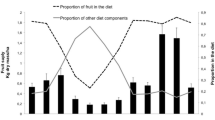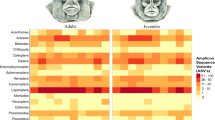Abstract
Individual trees of the food species of monkeys were identified by placing plastic tapes with an identification number on them in the tropical rain forest of Cameroon, West Africa. In order to determine the use of the feeding trees by monkeys, the ground under each of the trees was checked at least once a week to see if there were any fallen fruits or traces of feeding on fruits. Some fruit species were not fed on by either monkeys or large arboreal squirrels. Among the food species common to both the monkeys and large squirrels, a larger proportion in terms of quantity in each species was mainly eaten by the monkeys except in the case of super-abundantly fruit producing species. The monkeys and large arboreal squirrels were well segregated in their diets. Larger proportions (more than 85% for most of the monkeys' major foods) of fruits of larger sizes were made to fall on the ground by the monkeys and squirrels. The monkeys displayed a tendency to visit fruiting trees rather evenly (even rate of visit = even frequency of visit/duration of fruiting) not ignoring any area of the home range, although a small difference in this tendency was observed between the two study periods, one an abundant season and the other a poor fruiting season. On average, one associated polyspecific group of monkeys encountered only 14 fruiting trees per day. On the other hand, fruits were available all around the year, as the fruiting periods of different tree species were widely distributed around the year, or the fruiting periods of some species were very long. Although the monkeys are able to depend heavily on fruits, the quantity of fruits is not so great. The population size of monkeys is well balanced with the available food supply in the tropical rain forest of West Africa.
Similar content being viewed by others
References
Alexandre, D. Y., 1978. Le rôle disséminateur des éléphants en forêt de Tai, Côte-d'Ivoire.Terre et Vie, 32: 47–72.
Clutton-Brock, T. H. &P. H. Harvey, 1977. Species differences in feeding and ranging behaviour of primates. In:Primate Ecology,T. H. Clutton-Brock (ed.), Academic Press, London, New York, & San Francisco, pp. 557–584.
Coelho, A. M., C. A. Bramblett, L. B. Quick, &S. S. Bramblett, 1976. Resource availability and population density in primates: a socio-bioenergetic analysis of the energy budgets of Guatemalan howler and spider monkeys.Primates, 17: 63–80.
Emmons, L. H., 1980. Ecology and resource partitioning among nine species of African rain forest squirrels.Ecol. Monogr., 50(1): 31–54.
Gartlan, J. S. &T. T. Struhsaker, 1972. Polyspecific associations and niche separation of rain-forest anthropoids in Cameroon, West Africa.J. Zool. London, 168: 221–266.
Gautier-Hion, A. &J. P. Gautier, 1974. Les associations polyspécifiques de cercopitheques du M'passa.Folia Primatol., 22: 134–177.
,L. H. Emmons, &G. Dubost, 1980. A comparison of diets of three major groups of primary consumers of Gabon (primates, squirrels and ruminants).Oecologia, 45: 182–189.
,R. Quris, &J. P. Gautier, 1983. Monospecific vs. polyspecific life: a comparative study of foraging and antipredatory tactics.Behav. Ecol. Sociobiol., 12: 325–335.
,J. M. Duplantier, R. Quris, F. Feer, C. Sourd, J.-P. Decoux, G. Dubost, L. Emmons, C. Erard, P. Hecketsweiler, A. Moungazi, C. Roussilhon, &J.-M. Thiollay, 1985. Fruit characters as a basis of fruit choice and seed dispersal in a tropical forest vertebrate community.Oecologia, 65: 324–337.
Hoshino, J., 1985. Feeding ecology of mandrills (Mandrillus sphinx) in Campo Animal Reserve, Cameroon.Primates, 26: 248–273.
,A. Mori, H. Kudo, &M. Kawai, 1984. Preliminary report on the grouping of mandrills (Mandrillus sphinx) in Cameroon.Primates, 25: 295–307.
Iwamoto, T., 1978. Food availability as a limiting factor on population density of the Japanese monkey and gelada baboon. In:Recent Advances in Primatology,D. J. Chivers &J. Herbert (eds.), Academic Press, London, pp. 287–303.
Kudo, H. &M. Mitani, 1985. New record of predatory behavior by the mandrill in Cameroon.Primates, 26: 161–167.
McKey, D., P. G. Waterman, C. N. Mbi, J. S. Gartlan, &T. T. Struhsaker, 1978. Phenolic content of vegetation in two African rain forests: ecological implications.Science, 202: 61–64.
Mizuno, A., M. Kawai, &S. Ando, 1976. Ecological studies of forest-living monkeys in the Kibale Forest of Uganda. In:Kyoto Univ. African Studies,Y. Tani (ed.), 10: 1–35.
Mori, A., 1979. Analysis of population changes by measurement of body weight in the Koshima troop of Japanese monkeys.Primates, 20: 371–397.
Sourd, C. &A. Gautier-Hion, 1986. Fruit selection by a forest guenon.J. Anim. Ecol., 55: 235–244.
Struhsaker, T. T., 1978. Food habits of five monkey species in the Kibale Forest, Uganda. In:Recent Advances in Primatology, Vol. 1, Behaviour,D. J. Chivers &J. Herbert (eds.), Academic Press, London, pp. 225–248.
Sugiyama, Y., 1968. Social organization of chimpanzees in the Budongo forest, Uganda.Primates, 9: 225–258.
, 1985. The brush-stick of chimpanzees found in south-west Cameroon and their cultural characteristics.Primates, 26: 361–374.
Takasaki, H., 1981. Troop size, habitat quality, and home range area in Japanese macaques.Behav Ecol. Sociobiol., 9: 277–281.
, 1984. A model for relating troop size and home range area in a primate species.Primates, 25: 22–27.
Author information
Authors and Affiliations
About this article
Cite this article
Mori, A. Utilization of fruiting trees by monkeys as analyzed from feeding traces under fruiting trees in the tropical rain forest of Cameroon. Primates 29, 21–40 (1988). https://doi.org/10.1007/BF02380847
Received:
Accepted:
Issue Date:
DOI: https://doi.org/10.1007/BF02380847




